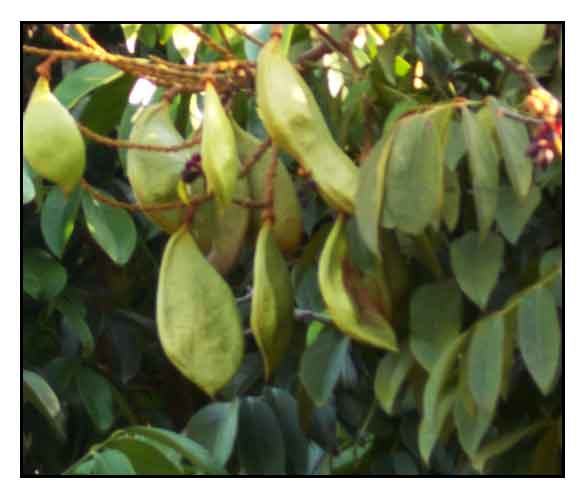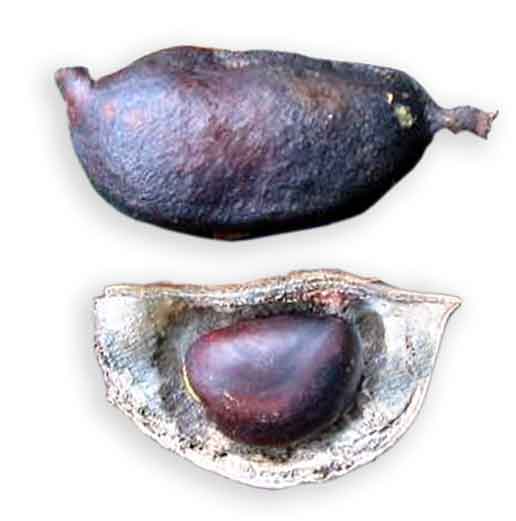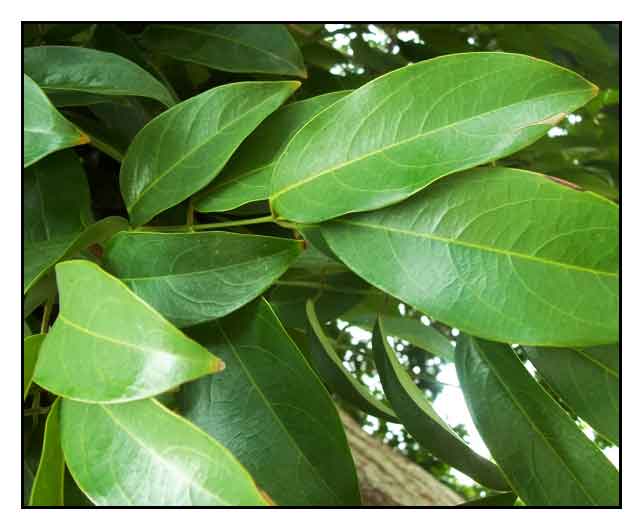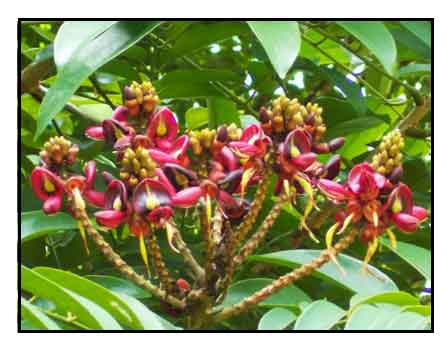 Gen info Gen info
- Adinobotrys is a genus of flowering plant in the family Fabaceae.
-
Taxonomy: The genus Adinobotrys was first described in 1911 by Stephen Troyte Dunn.
In 1994, most of the species were transferred into Callerya. In 2019, molecular phylogenetic study showed Adinobotrys was not closely related to Callerya, and resurrected the genus. As of 2022, Plants of the World Online listed four species. (8)
- Etymology: The species epithet atropurpureus derives from Latin words ater meaning black and purpureus meaning purple, referring to the dark purple flowers. (10)
-
In Thailand, it is the provincial tree of Nakhon Si Thammarat Province. (2)
 Botany Botany
• Callerya atropurpurea is an evergreen tree with a dense dome-like crown, growing up to 30 meters Trunk is cylindrical and slender, up to 45 centimeters in diameter, free of branches for about 13 meters, with steep buttresses 150 to 300 centimeters high, 20 centimeters thick and 4o to 60 centimeters out from the tree. Bark is grayish, smooth and thin. Leaves are alternate, imparipinnate, with 7 to 11 oblong-ovate leaflets, with entire margins and obtuse apex, 6 to 15 centimeters long and 2.5 to 5 centimeters wild, coriaceous, glossy and intense green in color. Inflorescences are compact terminal panicles, 12 to 20 centimeters long, bearing numerous papilionaceous flowers about 2 centimeters long, dark purple. Fruits are ovate to elliptic legumes, dehiscent, 8 to 15 centimeters long and 4 to 6 centimeters wide, initially purple red and brown on ripening, containing 3 to 4 lenticular seeds, about 3 to 4 centimeters in diameter and 2 to 2.5 centimeters thick; occasionally containing only one seed, up to 7 centimeters in diameter. (4)
• Growth form: Large evergreen tree with a thick, umbrella-shaped or round crown. Trunk: Tall trunk with light gray, shallowly cracked bark. Foliage: Pinnately compound leaves with 3 - 5 pairs of large, elliptic leaflets. Leaves are smooth and glossy with entire leaf margins. Flowers: Asymmetrical, bisexual flowers have red to purple petals. Petals are cup-shaped and overlap one another with the larger petal held above the smaller. Flowers release an unpleasant aroma. Inflorescence is a panicle in which several spike inflorescences branch off a main axis. It is located near the branch tips. Fruit: Dehiscent, dry fruits are dark brown pods. Oblong, woody pods have curved, pointed tips (10 - 15 cm long). Each pod produces 1 - 2 brown oval seeds (7 cm long). (10)
 Distribution Distribution
- Introduced.
- Cultivated, not naturalized.
- Native to Cambodia, Jawa, Laos, Malaya, Myanmar, Sumatera, Thailand, Vietnam.
(1)
- Widely planted as an ornamental tree.
Constituents
- Contains anti-tumor compound Millepurone. (see study below) (6)
Poison concerns
- Roots and seeds are poisonous due to the presence of cyanogenic glycosides
- Branches and roots contain rotenone, a broad-spectrum insecticide.
- Rotenone is classified by the WHO as moderately hazardous. (see study below) (3)
Properties
- Flowers emit an unpleasant odor.
- Toxicity of Millettia species. (see study below) (3)
- Studies have suggested toxicity, antitumor, anti-inflammatory
properties.
Parts used
Leaves, twigs, roots.
 Uses Uses
Edibility
- Tender young leaves are edible.
- In Thailand, called "Saw", fresh leaves are eaten with chili paste.
Folkloric
- No reported folkloric medicinal use in the Philippines.
Others
- Fish poison: Plant is piscicidal; twigs and roots used to stupefy fish.
- Insecticide: Used as insecticide. Twigs and roots contain rotenone
- Wood: Suitable for medium construction, interior finishing, paneling, furniture, flooring, boxes and crates and ornamental items. (3)
- Fuel: Seeds have potential use as biodiesel fuel.
 Studies Studies
• Millepurone / Anti-Tumor: A screening study for anti-tumor promoters isolated fifteen isoflavonoids from the plants of the genus Millettia. M. atropurpurea yielded millepurone, an oxidized isoflavone analogue, showed marked inhibitory effect on mouse skin tumor promotion in a in-vivo two-stage carcinogenesis test. (6)
• Muscarinic Receptor Binding Activity / Leaves: Study screened 234 extracts of Malaysian plant species for muscarinic receptor binding activity. Millettia atropurpurea leaves showed ± inhibitory activity (1-20%). (7).
• Toxicity / Rotenone: Millettia species contain a range of toxic substances, especially isoflavones. The best known is rotenone, which is found especially in seeds and roots. Rotenone is classified by the WHO as moderately hazardous, mildly toxic to humans and mammals, while extremely toxic to insects and to aquatic life. The lowest lethal dose for a child is 143 mg/kg. Other than deliberate ingestion, human deaths from rotenone poisoning are rare because it is quite irritating and causes vomiting early after ingestion. (3)
• Anti-Inflammatory / Amelioration of Gastric Injury and Septic Shock: Study evaluated the mechanism of anti-inflammatory activity of C. atropurpurea ethanol extract (Ca-EE) in vitro and invivo using murine macrophage cells and mouse models for gastritis and septic shock. Results showed Ca-EE significantly decreased LPS-induced NO-production, but hardly stimulated expression of NO. It showed no cytotoxicity, and also protected cells from LPS damage. Ca-EE alleviated HCl/EtOH-induced gastritis and LPS/poly(I:C)-induced septic shock through various signaling cascades. Study showed
Ca-EE exhibited an integrated and promising mechanism against TLR4-related inflammation, and showed potential for treating gastritic, septic shock, and other inflammatory diseases. (11)
• Antiallergic: Study evaluated the antiallergic mechanism of C. atropurpurea ethanol extract (Ca-EE) using invitro assays and an invivo atopic model. The Ca-EE comprised cis-raphasatin, lupeol, some sugars, and fatty acids. In RBL-2H3 cells, the Ca-EE treatment significantly reduced activities of lipoxygenase and ß-hexosaminidase, as well as cytokine gene expression. IgE-mediated signaling was downregulated by blocking Lyn kinases. Ca-EE also effectively inhibited allergic symptoms in the DNCB-induced atopic dermatitis model without toxicity. Results suggest Ca-EE exhibited antiallergic activities through regulation of IgE/Lyn signaling in RBL-2H3 cells and a contact dermatitis model. Results suggest potential for treatment of allergic diseases. (12)
Availability
Wildcrafted.
Cultivated. |

![]()



 Gen info
Gen info
 Distribution
Distribution Uses
Uses Studies
Studies 